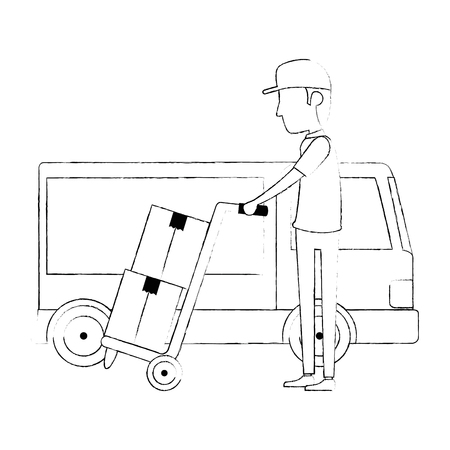1. Understanding Your Catering Vehicle Choices in the UK
The British street food scene is as diverse as it is dynamic, and choosing the right catering vehicle can make or break your business. The options available in the UK market are plentiful, ranging from classic catering vans and trailers to quirky tuk tuks and fully converted double-decker buses. Each type comes with its own set of advantages, costs, and practical considerations—so it’s crucial to match your choice with both your menu ambitions and your target customers. Vans and trailers remain the workhorses for many operators, ideal for fish & chips, burgers, and coffee, thanks to their reliability and relatively straightforward fit-outs. If you’re looking to stand out at markets or festivals, vintage vehicles like Citroën HY vans or even repurposed black cabs tap into that nostalgic British vibe while drawing crowds. On the other end of the spectrum, tuk tuks offer ultra-mobility for tight city spots, perfect for quick-serve concepts like falafel or loaded fries. For those aiming big—think gourmet pizza or multi-dish menus—a converted bus offers ample kitchen space and sometimes even a seating area upstairs, making it an eye-catching hub at large events. Ultimately, your choice should reflect both the flavours you serve and the experience you want to deliver—because in today’s competitive UK street food market, being memorable is half the battle won.
Weighing Up New vs Used Vehicles
When it comes to choosing your catering vehicle in the UK, one of the most fundamental decisions is whether to invest in a brand-new model or opt for a second-hand van. Both routes have their champions and critics, and the British market offers plenty of choice. Here’s a practical look at the pros, cons, and classic mistakes—plus what seasoned UK food entrepreneurs really consider before signing on the dotted line.
New Vehicles: The Pros and Cons
| Pros | Cons |
|---|---|
| Manufacturer’s warranty Latest tech & fuel efficiency Customisable fit-out from scratch Peace of mind regarding reliability |
High upfront cost (can be £40k+ easily) Immediate depreciation Longer lead time for delivery/fit-out Insurance premiums can be higher |
Common Pitfalls with New Vehicles
- Over-customisation: It’s tempting to spec every bell and whistle, but this rapidly inflates costs.
- Underestimating lead times: Building your dream van from scratch can take months—vital if you’re racing to launch for summer festivals.
- No trading history: Lenders may hesitate to finance a new business with a big-ticket new van, especially if you’ve yet to prove your concept works in the UK market.
Used Vehicles: The Pros and Cons
| Pros | Cons |
|---|---|
| Lower upfront investment Often ready-to-go or partially fitted Quicker to get started Easier cashflow management early on |
Potential hidden faults or repairs needed Shorter lifespan if heavily used Limited customisation options Might not meet all council hygiene regs without upgrades |
Common Pitfalls with Used Vehicles
- Poor maintenance records: Always check service history; skimping here leads to nasty MOT surprises.
- Bargain blindness: Don’t buy based solely on price—a van that’s too cheap often hides expensive problems.
- Mismatched fit-outs: A previous owner’s set-up might not match your menu or workflow, leading to awkward (and costly) retrofits.
What British Food Entrepreneurs Prioritise
The most successful traders in the UK catering scene know it’s not just about shiny kit or bargain buys. They focus on:
- Total cost of ownership: Factoring running costs, insurance, and likely repairs into their decision.
- Council compliance: Ensuring any vehicle meets local authority requirements for hygiene and food safety—especially important for street food pitches in cities like London or Manchester.
- Brand fit: Choosing vehicles that match their concept—classic Citroën H vans for artisan coffee, rugged Transits for high-volume events, or quirky Piaggio Apes for niche markets.
- Exit strategy: Thinking ahead—will this vehicle hold its value if they need to sell up or scale?
This isn’t just about buying wheels; it’s about setting yourself up for long-term trading success in the uniquely competitive British street food landscape.

3. Fit-Out Essentials: What You Actually Need
When it comes to kitting out your catering vehicle for the UK market, it’s far too easy to burn cash on shiny extras you simply don’t need—trust me, I’ve seen startups struggle after dropping their budget on fancy coffee machines before buying a decent fridge. Here’s what really matters if you want to avoid costly rookie mistakes and stay on the right side of British law.
The Must-Have Equipment
Cooking Appliances: The heart of your fit-out. Your menu dictates what you need, but nearly every UK food truck will require at least one fryer or griddle (often both), and a reliable oven if you’re baking or roasting. Don’t go overboard: buy commercial-grade kit that fits your space, power supply and menu needs, not just what looks impressive.
Refrigeration: Environmental Health Officers are relentless about safe food storage. You’ll need a commercial fridge (undercounter units are popular for saving space), and in most cases, a separate freezer. Avoid domestic fridges—they won’t pass inspection and can fail under pressure.
Hot Water & Handwashing: A plumbed-in sink with hot water is non-negotiable by UK standards. Many startups try to cut corners here; don’t be that person. Portable sinks rarely meet requirements long-term.
Extractor Fans & Ventilation: If you’re frying or grilling, extraction is essential for both safety and legal compliance. Steam and grease build-up is a nightmare; proper ventilation also keeps inspectors happy and staff healthy.
Electrics & Gas: Safety First
Whether you’re running electrics off a generator or plugging into event mains, everything must be installed by a certified professional (Part P registered for electrics). For gas appliances, insist on an annual Gas Safe certificate—it’s illegal to operate without one in the UK. Skimping here is a classic startup error that can get you shut down fast.
Other Legal Requirements
- Fire Safety: At least one fire extinguisher (foam or powder) and a fire blanket are mandatory.
- Allergens & Labelling: Clear signage for allergens is now strictly enforced across the UK—get this wrong and you risk fines or worse.
- PAT Testing: All electrical equipment must be PAT tested annually for public events and most markets.
The Takeaway from Hard-Earned Lessons
Avoid buying gear “just in case” or because someone else has it; focus on equipment you actually need to operate safely and legally within the UK. Do your research, talk to other operators, and remember—every extra appliance means less space and more headaches down the line. Getting these basics right from day one saves money, avoids legal trouble, and lets you focus on serving great food instead of firefighting problems.
4. True Costs: Breaking Down Your Budget
Let’s talk hard cash—because it’s not just the van you’re buying, it’s the whole operation. In the UK, budgeting for your catering vehicle means looking beyond the sticker price. Here’s what you need to know before you commit your life savings—or worse, your mum’s house—to your dream food truck.
Vehicle Purchase Costs
Your starting point is the vehicle itself. New or used? That decision alone can make or break your initial spend.
| Vehicle Type | New (Approx.) | Used (Approx.) |
|---|---|---|
| Small Van (e.g., Ford Transit Connect) | £18,000–£25,000 | £7,000–£12,000 |
| Larger Van (e.g., Mercedes Sprinter) | £30,000–£45,000 | £13,000–£20,000 |
| Classic Citroën H Van (Restored) | N/A | £25,000–£35,000 |
| Trailer Conversion | £10,000–£20,000 | £5,000–£12,000 |
Fit-Out and Equipment Expenses
The fit-out is where many get caught off-guard. A basic setup with just a sink and electrics might set you back £5,000–£8,000. A professional-grade kitchen with fryers, grills, extraction fans and branded wrap? Budget £15,000–£30,000 easily. Don’t forget gas safety certificates and electrical compliance—non-negotiable in the UK.
Typical Fit-Out Breakdown:
- Bespoke stainless kitchen & install: £8,000–£20,000+
- Branding/wrap: £1,500–£4,500 (depending on design complexity)
- Gas & Electrical Certification: £200–£500 annually
- Extractor fan system: £700–£2,500
- Catering equipment (fridges/grills): £2,500–£6,000+
Insurance and Compliance Costs
You can’t legally trade without public liability insurance (£350–£750/year), vehicle insurance (£800–£2,500/year for catering vans) and product liability cover. Factor in local council licensing fees (£100–£1,200 per year depending on borough), plus an annual MOT and regular maintenance—because British weather is murder on brakes and bodywork.
Hidden Expenses: What Catches Out Most Startups?
- Pitch Fees: Markets and festivals can charge from £30/day to £1,500+ for major events like Glastonbury.
- PAT Testing (Electrical Appliances): £60–£150 annually.
- Bespoke adaptations (serving hatches/awnings): £300–£2,000.
- Unexpected Repairs: Always have at least £2k buffer for breakdowns or urgent fixes.
- Storage & Parking: Especially in London—can be up to £250/month if you need secure space.
The Bottom Line: Realistic Startup Range in 2024 UK Market
| Total Initial Investment Category | Estimated Cost Range (£) |
|---|---|
| Shoestring (DIY fit-out/used van) | £15,000 – £22,000 |
| Semi-Professional (used van/pro fit-out) | £28,000 – £38,000 |
| Aim High (new van/full bespoke fit-out) | £45,000 – £70,000+ |
If you want to survive—and thrive—in the UK’s fiercely competitive catering scene, budget ruthlessly. Go in with eyes wide open and a contingency fund for those ‘just-in-case’ moments that always crop up. The upfront numbers might look scary now but cutting corners will cost you more in the long run.
5. Finding Your Supplier: Tips and Red Flags
Choosing the right supplier for your catering vehicle is just as critical as picking the van itself. The UK market is awash with suppliers, from established fit-out specialists to one-man bands working out of their backyard. Here’s how to separate the wheat from the chaff—and avoid costly mistakes that could put your mobile food business on the back foot from day one.
Proven Strategies for Sourcing Reputable UK Suppliers
Start by tapping into the power of word-of-mouth. Ask around in local Facebook groups, speak to traders at food markets, and attend street food events—most successful operators are happy to share their supplier recommendations (and horror stories). Always check for a physical address, a company registration number, and a portfolio of completed projects. The best suppliers will welcome you to their workshop and show you vehicles in progress, so you can see their workmanship up close.
Check Credentials and Reviews
Don’t take glossy websites at face value. Dig into online reviews on Trustpilot and Google, but also look for discussions in trade forums and social media groups where customers share real experiences. Make sure your supplier provides proper documentation—like gas and electrical safety certificates—especially if you’re planning to trade at council-run events or festivals, where compliance is non-negotiable.
Avoiding Cowboy Traders: What to Watch Out For
The UK catering vehicle scene has its fair share of cowboys—operators who overpromise, underdeliver, and sometimes vanish with your deposit. Classic warning signs include vague quotes, requests for large upfront payments (more than 30% should ring alarm bells), and reluctance to provide references or let you view previous builds. If they dismiss written contracts or try to pressure you into a quick decision because “slots are filling up fast,” walk away.
Lessons Learned: Blood, Sweat, and Costly Errors
I’ve seen too many new entrants burned by slick-talking traders who cut corners on insulation, use substandard kitchen equipment, or fit out vehicles with dodgy electrics that fail inspection. One hard lesson: always insist on a staged payment plan linked to clear build milestones. And remember—if a deal sounds too good to be true in this business, it usually is.
Sourcing the right supplier takes legwork but pays off in peace of mind—and avoids those infamous British entrepreneurial “school fees.” Take your time, ask tough questions, and don’t compromise on due diligence. Your future self (and bank balance) will thank you.
6. Final Checks: Legalities, Licensing and Compliance
Before you can hit the road and start serving up your signature dishes, it’s crucial to ensure your catering vehicle ticks all the legal boxes in the UK. The last thing any budding food entrepreneur wants is to be shut down for missing paperwork or non-compliance with regulations. Here’s a practical rundown of what you need to sort out before launching your mobile catering business.
DVLA Registration and Vehicle Requirements
First off, make sure your chosen vehicle is fully road-legal. Register it with the DVLA, and if you’ve made any modifications during your fit-out—like installing gas appliances or extra electrics—inform them promptly. Depending on the weight and type of your catering van or trailer, you may require specific driving licences; don’t assume a standard car licence covers everything. Double-check your insurance too—standard policies won’t cut it for commercial catering use.
Food Safety Standards
No matter how tempting your menu, local councils will want proof that you’re handling food safely. Register your business with the local Environmental Health department at least 28 days before trading. You’ll need to comply with strict hygiene standards: think handwashing stations, easy-to-clean surfaces, pest control measures, and robust temperature controls. Expect regular inspections—councils take this seriously, and a poor hygiene rating can kill your business before it gets started.
Council Permits and Trading Licences
If you plan to trade on public land—high streets, markets, festivals—you’ll need a street trading licence from the relevant council. The application process can be lengthy (sometimes up to three months), so get started early. Different councils have different rules about where, when and what you can sell—ignore these at your peril. If you’re planning to operate on private land (like brewery yards or event spaces), written permission from the landowner is essential.
Other Compliance Considerations
Don’t forget about waste disposal contracts (for oil, rubbish, and grey water), fire safety equipment checks, and allergen labelling compliance under Natasha’s Law. Some sites may also require proof of PAT testing for electrical equipment or gas safety certificates for LPG appliances.
Summary: Get Road-Ready the Right Way
The UK market is packed with opportunity for caterers—but only if you play by the rules. By thoroughly checking off DVLA requirements, upholding food safety standards, securing council permits, and staying on top of ongoing compliance, you’ll be able to launch with confidence—and avoid costly mistakes that could derail your venture before it even gets going.


